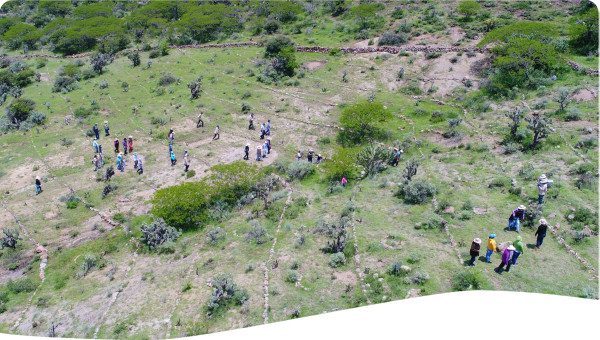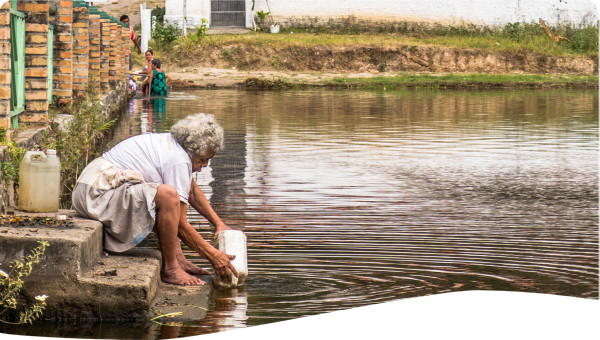Burkina Faso is increasingly affected by climate variability, characterized by severe floods and droughts that negatively impact key economic sectors and communities. In response, the National Water Partnership of Burkina Faso (PNE-BF) implemented a community-based flood and drought management initiative in the village of Badara. The initiative aimed to enhance community resilience to recurrent flood and drought events under the project “Integrating Flood and Drought Management and Early Warning for Climate Change Adaptation in the Volta Basin” (VFDM, 2019–2023), funded by the Adaptation Fund.
Challenges:
Badara, located 5 km southeast of Bama and 20 km from Bobo-Dioulasso, has a Sudanian climate and is highly vulnerable to disasters—with a composite disaster risk exposure index of 5.55 (on a scale from 0 to 10), including 3.91 for floods and 7.00 for droughts (ABV, 2021). Vulnerability is exacerbated by migration, precarious housing, and unemployment. The village lacked early warning systems and risk prevention infrastructure.

Initiative Objective:
To strengthen capacity and resilience of vulnerable communities in Badara against floods and drought. Specific objectives included:
- Improving risk management capacity,
- Enhancing community self-help and participation in early warning systems,
- Facilitating local involvement in awareness and risk reduction activities.
Target Groups and Beneficiaries:
The initiative involved technical services (e.g., water, sanitation, agriculture), local councils, and national agencies. Beneficiaries included the people of Badara, Diarradougou, and Sandémisso—village leaders, women and youth groups, farmers, herders, traders, and the Village Development Council.
Methodological Approach
The initiative was implemented using a participatory and inclusive approach. Activities included:
- Stakeholder identification and risk assessment,
- Planning and capacity-building workshops,
- Formation of the CMCFD and development of governance documents,
- Installation of meteorological and early warning equipment,
- Implementation of a management plan (PGCIS),
- Capitalization and dissemination of best practices (including a documentary film).
Key Areas of Intervention
1. Enabling Environment:
The PGCIS addressed key flood and drought challenges and became a tool for seeking funding. Advocacy with the Mouhoun Water Agency (AEM) was conducted. Flood-prone areas were mapped, buffer zones advocated, and hundreds of mango trees planted to stabilize riverbanks.
2. Institutions and Participation:
Over 100 people from Badara and nearby villages were trained on climate change, water management, and disaster risk reduction. The CMCFD, established by municipal decree and integrated into the Village Development Council, represents all social groups. Training included gender integration, advocacy, and project development. Local advocacy improved water usage and reduced pollution conflicts.
3. Management Instruments:
The PGCIS promoted efficient water use, drought-resilient species, and sustainable practices (e.g., organic fertilizers). Early warning systems were established with upstream villages. Equipment included meteorological stations, gauges, alarms, flag signals, and speakers. The community was trained in equipment use and interpretation of alerts.
4. Financing:
Funding came from the Adaptation Fund through the VFDM project, with contributions from national partners like AEM. Communities were sensitized on financial contributions (e.g., water usage fees). Total cost: 13,750,000 FCFA over 12 months (Sept 2021 – Sept 2022).
Key achievements from the initiative included: community training on flood and drought management, installation of meteorological and hydrometric equipment, and establishment of early warning and information systems. A Community Management Committee for Floods and Droughts (CMCFD) was formed, and a Community Flood and Drought Management Plan (PGCIS) was developed and implemented. These actions contributed to strengthening community self-help capacity and enhanced the effectiveness of national forecasting and response services.
The impact of this initiative are:
- Enhanced flood/drought response due to the meteorological station and early warning systems,
- Greater awareness and preparedness, especially among youth,
- Functional CMCFD actively conducting monitoring, alerting, and advocacy,
- Improved water equity and coordination during dry seasons.
Lessons Learned:
- Community ownership of early warning systems was key,
- More funding is needed to fully implement both structural and non-structural risk reduction activities,
- PNE-BF played a unifying role, enabling cooperation across stakeholders.
Success and Sustainability Factors:
- Effective partnerships and community ownership,
- Documentation and sharing of best practices,
- Strong gender-inclusive capacity building,
- Institutionalization of the CMCFD,
- Financing through mechanisms like the CFE (water usage fees).
Key recommendations:
- Continue technical capacity-building and resource mobilization,
- Upgrade hydrometeorological monitoring with automatic equipment,
- Build infrastructure and provide emergency supplies to victims,
- Scale the initiative to other communities through national disaster risk agencies and local governments,
- Increase resource mobilization to expand upstream and downstream interventions.



